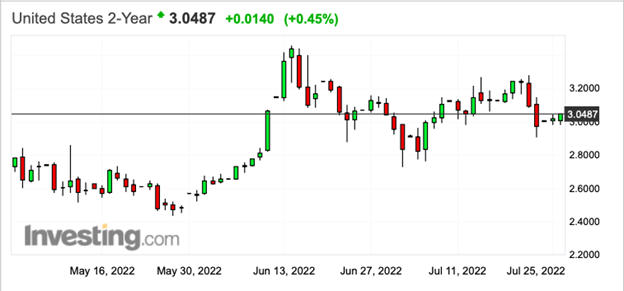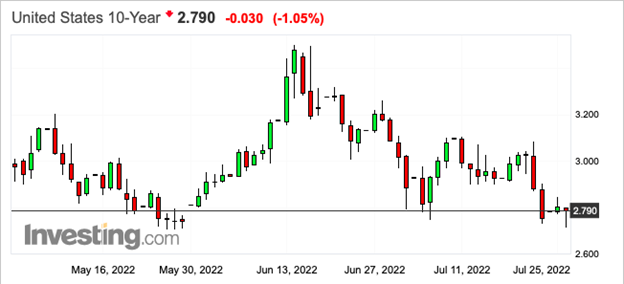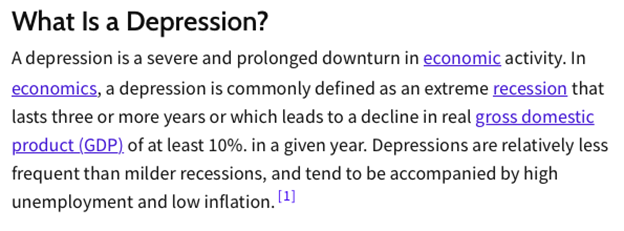Since summer of 2020, we've argued that stagflation would be the ultimate outcome of the Covid lockdowns and resulting surge of QE and cash creation. And now here we are.
Later this week, the first official guess at U.S. Q2 GDP will be released, and it is very likely to show another contraction. The long-standing definition of a recession has been two consecutive quarters of economic contraction, and since Q1 came in at -1.6%, any negative print this Thursday will place the U.S. economy "officially" into recession.

Politicians and political economists will argue that the official definition should be more nuanced, as in the NBER statement above. But that NBER definition is usually only confirmed with about 9-12 months of lag time, and any thinking, unbiased person should be able to safely assume that if it walks like a duck and quacks like a duck, then it's a duck. The same is true for the current economic environment of GDP contraction, plummeting PMIs, soaring mortgage rates, and collapsing profit margins. These are consistent with recession…and here we are.
So what does that mean for the markets?
First of all, check how the U.S. treasury market is confirming this diagnosis. The FOMC is scheduled to raise the fed funds rate again on Wednesday, and the short end of the yield curve has continued to be stuck in the area around 3.00%. See below:

But longer-term notes and bonds are rallying with yields falling. Why? Because fixed income traders and investors are recognizing the economic downturn and rushing to lock in yields before they fall further.

You can surely do the simple math and compute that the 2s-10s yield curve is now inverted by a whopping 26 basis points! And what does an inverted yield curve imply? You guessed it...a pending recession.
So what does this signal for precious metals investors?
Simply put, the Fed will be forced to end their rate hike scheme well before the fed funds rate gets above the stated CPI inflation rate. If they do not, the severity of the economic downturn will worsen and the Fed will begin flirting with a recession that borders upon depression.

Other markets have already begun to anticipate this eventual change in Fed policy. As mentioned above, the bond market has begun to rally with the yield on the 10-year note falling from a high of 3.50% on June 14 to a low of 2.70% on July 26. This has led to lower inflation-adjusted or "real" interest rates, as evidenced by the TIP ETF, which moves up as real rates fall (and vice versa.) Note the recent rally from lows near 113.

After falling over 20% in the first half of 2022, the stonk market looks to be stabilizing too.

And perhaps most importantly, the U.S. Dollar Index may be starting to roll over after a powerful rally of nearly 20% since this time last year.

COMEX gold and silver and the rest of the commodity sector have not yet begun to trade higher off this unavoidable Fed policy shift, but they will. Just give them time. And when the shift comes, it will impact prices quickly and furiously as the stark reality of the economic situation begins to take hold.
So we'll end this week with a reminder: Every time the Fed has tried to slow and/or reverse their debt monetization policies since 2009, they've had to rush to catch up and the subsequent QE programs have all grown.
- In early 2016, the U.S economy stalled and the Fed was forced to slow their "Quantitative Tightening" schedule. Gold rallied from $1050 to $1350 (+29%).
- In early 2019, a liquidity collapse forced the Fed to reverse course on higher interest rates in order to support the equity and fixed income markets. Gold rallied from $1200 to $1550 (+29%).
- In early 2020, the Covid lockdowns led the Fed to flood the markets with liquidity via QE and other measures. Gold rallied from $1450 to $2050 (+41%).
When the Fed inevitably pivots again, a similar 30-40% rally from current levels would lead to a COMEX gold price in the $2200-2300 range. After the pain of the past 100 days, that may seem like a pipe dream, but all we're projecting here is a market reaction of a similar percentage to the most recent Fed pivots.
So now is not the time to be discouraged over your gold, silver, and mining share investments. The U.S. economy has slipped—or is slipping—into a prolonged period of economic stagflation. The Fed will soon be forced to pivot their current policies, and the markets will react in the same manner they have in the past.
Pay attention. Be ready. And prepare accordingly.


